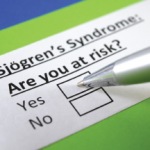Neuropathy
Shamik Bhattacharyya, MD, MS, assistant professor of neurology at Brigham and Women’s Hospital, Boston, discussed the various forms of neuropathy that can arise in patients with confirmed Sjögren’s syndrome. Dr. Bhattacharyya noted that, in 25–60% of cases, neurologic symptoms precede a diagnosis of Sjögren’s syndrome by months or years.1 When they do occur, such symptoms can manifest as cranial neuropathy, ganglionopathy, axonal polyneuropathy, multiple mononeuropathy and autonomic neuropathy.
Many clinicians are familiar with the use of electromyogram and nerve conduction studies (EMG/NCS) testing to evaluate neuropathic symptoms, but this diagnostic modality doesn’t test for small-fiber neuropathies. To evaluate this form of neuropathy, a skin biopsy can provide direct visualization of nerve fibers in the dermis, and pathologic examination can quantify the nerve fiber density. It’s essential to remember the normal ranges for nerve fiber density are affected by such factors as age, gender and ethnicity. Rheumatologists must make sure these factors are accounted for by the pathologist interpreting the biopsy specimen.
When a neuropathy is identified, clinicians must consider other causes, such as diabetes or vitamin deficiencies, in the differential before assuming the neuropathy is related to Sjögren’s syndrome. This is often easier said than done, because no specific biomarker identifies a neuropathy as related to Sjögren’s. Age can also serve as a confounder because older adults are more likely than younger individuals to develop Sjögren’s syndrome and are more likely to manifest neuropathies in general.2,3
In addition to examining the clinical features of the neuropathy, it can be helpful to look at the histopathologic features of nerve biopsies and evaluate these for evidence of lymphocytic infiltration. Magnetic resonance imaging (MRI) can be elucidative, but it can also be misleading. Example: Wallerian degeneration related to a ganglionopathy can result in T2 hyperintensity of the spinal cord, which can be read as primary spinal cord disease by the radiologist.
With regard to treatment of Sjögren’s-related neuropathies, Dr. Bhattacharyya admitted there’s a paucity of large, high-quality studies proving the efficacy of various immunosuppressive regimens. Although mycophenolate mofetil and other agents have demonstrated some effectiveness in case reports and small clinical trials, Dr. Bhattacharyya has made it his practice to discuss and manage the expectations of patients early in the therapeutic encounter. Often, he has patients return six weeks after the initial consultation and, if the neuropathy is progressing, he considers a trial of a steroid pulse treatment and extended steroid taper, with the goal of slowing the neuropathy’s progression.

